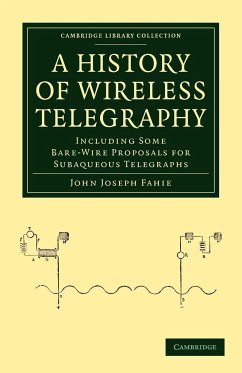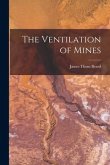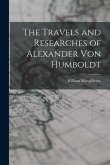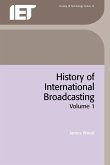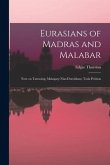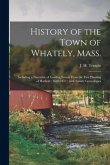John Joseph Fahie
A History of Wireless Telegraphy
John Joseph Fahie
A History of Wireless Telegraphy
- Broschiertes Buch
- Merkliste
- Auf die Merkliste
- Bewerten Bewerten
- Teilen
- Produkt teilen
- Produkterinnerung
- Produkterinnerung
In this 1901 book, the telegraph engineer John Joseph Fahie explained the newly invented and rapidly developing technology of radio.
Andere Kunden interessierten sich auch für
![The Ventilation of Mines The Ventilation of Mines]() James Thom BeardThe Ventilation of Mines20,99 €
James Thom BeardThe Ventilation of Mines20,99 €![The Travels and Researches of Alexander Von Humboldt The Travels and Researches of Alexander Von Humboldt]() William MacgillivrayThe Travels and Researches of Alexander Von Humboldt27,99 €
William MacgillivrayThe Travels and Researches of Alexander Von Humboldt27,99 €![History of International Broadcasting History of International Broadcasting]() James WoodHistory of International Broadcasting63,99 €
James WoodHistory of International Broadcasting63,99 €![Explosives: History with a Bang Explosives: History with a Bang]() G. I. BrownExplosives: History with a Bang14,99 €
G. I. BrownExplosives: History with a Bang14,99 €![The Revolutions, Insurrections and Conspiracies of Europe; 2 The Revolutions, Insurrections and Conspiracies of Europe; 2]() The Revolutions, Insurrections and Conspiracies of Europe; 226,99 €
The Revolutions, Insurrections and Conspiracies of Europe; 226,99 €![Eurasians of Madras and Malabar; Note on Tattooing; Malagasy-Nias-Dravidians; Toda Petition Eurasians of Madras and Malabar; Note on Tattooing; Malagasy-Nias-Dravidians; Toda Petition]() Edgar ThurstonEurasians of Madras and Malabar; Note on Tattooing; Malagasy-Nias-Dravidians; Toda Petition16,99 €
Edgar ThurstonEurasians of Madras and Malabar; Note on Tattooing; Malagasy-Nias-Dravidians; Toda Petition16,99 €![History of the Town of Whately, Mass.: Including a Narrative of Leading Events From the First Planting of Hatfield: 1660-1871: With Family Genealogies History of the Town of Whately, Mass.: Including a Narrative of Leading Events From the First Planting of Hatfield: 1660-1871: With Family Genealogies]() History of the Town of Whately, Mass.: Including a Narrative of Leading Events From the First Planting of Hatfield: 1660-1871: With Family Genealogies25,99 €
History of the Town of Whately, Mass.: Including a Narrative of Leading Events From the First Planting of Hatfield: 1660-1871: With Family Genealogies25,99 €-
-
-
In this 1901 book, the telegraph engineer John Joseph Fahie explained the newly invented and rapidly developing technology of radio.
Hinweis: Dieser Artikel kann nur an eine deutsche Lieferadresse ausgeliefert werden.
Hinweis: Dieser Artikel kann nur an eine deutsche Lieferadresse ausgeliefert werden.
Produktdetails
- Produktdetails
- Verlag: Cambridge University Press
- Seitenzahl: 378
- Erscheinungstermin: 13. Dezember 2010
- Englisch
- Abmessung: 216mm x 140mm x 22mm
- Gewicht: 532g
- ISBN-13: 9781108026864
- ISBN-10: 1108026869
- Artikelnr.: 32869830
- Herstellerkennzeichnung
- Libri GmbH
- Europaallee 1
- 36244 Bad Hersfeld
- gpsr@libri.de
- Verlag: Cambridge University Press
- Seitenzahl: 378
- Erscheinungstermin: 13. Dezember 2010
- Englisch
- Abmessung: 216mm x 140mm x 22mm
- Gewicht: 532g
- ISBN-13: 9781108026864
- ISBN-10: 1108026869
- Artikelnr.: 32869830
- Herstellerkennzeichnung
- Libri GmbH
- Europaallee 1
- 36244 Bad Hersfeld
- gpsr@libri.de
Preface to second edition
Preface to first edition
First Period - the Possible: 1. Professor C. A. Steinheil, 1838
2. Edward Davy, 1838
3. Professor Morse, 1842
4. James Bowman Lindsay, 1843
5. J. W. Wilkins, 1845
6. Dr. O'Shaughnessy, 1849
7. E. and H. Highton, 1852-1872
8. G. E. Dering, 1853
9. John Haworth, 1862
10. J. H. Mower, 1868
11. M. Bourbouze, 1870
12. Mahlon Loomis, 1872
Second Period - the Practicable: 1. Preliminary. Notice of the telephone in relation to wireless telegraphy
2. Professor John Trowbridge, 1880
3. Professor Graham Bell, 1882
4. Professor A. E. Dolbear, 1882
5. T. A. Edison, 1885
6. W. F. Melhuish, 1890
7. Charles A. Stevenson, 1892
8. Professor Erich Rathenau, 1894
Third Period - the Practical: Systems in actual use
1. Sir W. H. Preece's method
2. Willoughby Smith's method
3. G. Marconi's method
Appendix A. The relation between electricity and light, before and after Hertz
Appendix B. Prof. Henry on high tension electricity being confined to the surface of conducting bodies, with special reference to the proper construction of lightning-rods. On modern views with respect to the nature of electric currents
Appendix C. Variations of conductivity under electrical influence
Appendix D. Researches of Prof. D. E. Hughes, F. R. S., in electric waves and their application to wireless telegraphy, 1879-1886
Appendix E. Reprint of G. Marconi's patent
Index.
Preface to first edition
First Period - the Possible: 1. Professor C. A. Steinheil, 1838
2. Edward Davy, 1838
3. Professor Morse, 1842
4. James Bowman Lindsay, 1843
5. J. W. Wilkins, 1845
6. Dr. O'Shaughnessy, 1849
7. E. and H. Highton, 1852-1872
8. G. E. Dering, 1853
9. John Haworth, 1862
10. J. H. Mower, 1868
11. M. Bourbouze, 1870
12. Mahlon Loomis, 1872
Second Period - the Practicable: 1. Preliminary. Notice of the telephone in relation to wireless telegraphy
2. Professor John Trowbridge, 1880
3. Professor Graham Bell, 1882
4. Professor A. E. Dolbear, 1882
5. T. A. Edison, 1885
6. W. F. Melhuish, 1890
7. Charles A. Stevenson, 1892
8. Professor Erich Rathenau, 1894
Third Period - the Practical: Systems in actual use
1. Sir W. H. Preece's method
2. Willoughby Smith's method
3. G. Marconi's method
Appendix A. The relation between electricity and light, before and after Hertz
Appendix B. Prof. Henry on high tension electricity being confined to the surface of conducting bodies, with special reference to the proper construction of lightning-rods. On modern views with respect to the nature of electric currents
Appendix C. Variations of conductivity under electrical influence
Appendix D. Researches of Prof. D. E. Hughes, F. R. S., in electric waves and their application to wireless telegraphy, 1879-1886
Appendix E. Reprint of G. Marconi's patent
Index.
Preface to second edition
Preface to first edition
First Period - the Possible: 1. Professor C. A. Steinheil, 1838
2. Edward Davy, 1838
3. Professor Morse, 1842
4. James Bowman Lindsay, 1843
5. J. W. Wilkins, 1845
6. Dr. O'Shaughnessy, 1849
7. E. and H. Highton, 1852-1872
8. G. E. Dering, 1853
9. John Haworth, 1862
10. J. H. Mower, 1868
11. M. Bourbouze, 1870
12. Mahlon Loomis, 1872
Second Period - the Practicable: 1. Preliminary. Notice of the telephone in relation to wireless telegraphy
2. Professor John Trowbridge, 1880
3. Professor Graham Bell, 1882
4. Professor A. E. Dolbear, 1882
5. T. A. Edison, 1885
6. W. F. Melhuish, 1890
7. Charles A. Stevenson, 1892
8. Professor Erich Rathenau, 1894
Third Period - the Practical: Systems in actual use
1. Sir W. H. Preece's method
2. Willoughby Smith's method
3. G. Marconi's method
Appendix A. The relation between electricity and light, before and after Hertz
Appendix B. Prof. Henry on high tension electricity being confined to the surface of conducting bodies, with special reference to the proper construction of lightning-rods. On modern views with respect to the nature of electric currents
Appendix C. Variations of conductivity under electrical influence
Appendix D. Researches of Prof. D. E. Hughes, F. R. S., in electric waves and their application to wireless telegraphy, 1879-1886
Appendix E. Reprint of G. Marconi's patent
Index.
Preface to first edition
First Period - the Possible: 1. Professor C. A. Steinheil, 1838
2. Edward Davy, 1838
3. Professor Morse, 1842
4. James Bowman Lindsay, 1843
5. J. W. Wilkins, 1845
6. Dr. O'Shaughnessy, 1849
7. E. and H. Highton, 1852-1872
8. G. E. Dering, 1853
9. John Haworth, 1862
10. J. H. Mower, 1868
11. M. Bourbouze, 1870
12. Mahlon Loomis, 1872
Second Period - the Practicable: 1. Preliminary. Notice of the telephone in relation to wireless telegraphy
2. Professor John Trowbridge, 1880
3. Professor Graham Bell, 1882
4. Professor A. E. Dolbear, 1882
5. T. A. Edison, 1885
6. W. F. Melhuish, 1890
7. Charles A. Stevenson, 1892
8. Professor Erich Rathenau, 1894
Third Period - the Practical: Systems in actual use
1. Sir W. H. Preece's method
2. Willoughby Smith's method
3. G. Marconi's method
Appendix A. The relation between electricity and light, before and after Hertz
Appendix B. Prof. Henry on high tension electricity being confined to the surface of conducting bodies, with special reference to the proper construction of lightning-rods. On modern views with respect to the nature of electric currents
Appendix C. Variations of conductivity under electrical influence
Appendix D. Researches of Prof. D. E. Hughes, F. R. S., in electric waves and their application to wireless telegraphy, 1879-1886
Appendix E. Reprint of G. Marconi's patent
Index.

